Introduction by the Author
Foreword
When I began to study Taiho Jutsu in 1981 little did I realise how much it would affect and change my life. Until that point I had practised and become knowledgeable in the sport of judo and a number of other martial arts. I did not know that I had only touched on the physical aspects, and that there had been a great void in the foundation of my knowledge.
Taiho Jutsu put me on the path that can only be described in Western language as enlightenment. What had been lacking was ‘Ki’.
My instructors in previous Martial Arts had neglected the essential format that made up any martial art. The Oriental import was missing, yes, the combat was there, I was good, even represented my country, but fulfilment had not been achieved. As a young man strength and stamina are paramount, but as an adult they begin to fail, only slightly if you maintain the standards, but fail they do. The hunger is still there but the speed of reaction slows, only fractionally it is admitted, but it is enough to be dangerous at a high level. When the ability to compete at international level goes, then there has to be something pretty sensational to take its place.
‘Ki’ is the embodiment of all enlightenment. It is the Centre, and around it provides all. ‘Ki’ made it possible to get the feeling, the essence of what it had all been about, the reason why we train, the reason why we achieve.
Taiho gave me a new direction. It made me apply myself, sure the techniques are strong, able to overcome any other martial art system, but in themselves not enough. Taiho gave me a thirst for knowledge. It made me realise how little I knew.
I began to cast my net, and in doing so I met a most startling man,George Saltries, he was 83 when I met him. He took me under his wing and I began to learn, a sponge in a bath, no matter how much I was able to soak up there was always so much more. He began with the physical aspects of ‘Ki’, the ability to apply it to techniques, achieving power that I had previously before thought of only as ‘book oriental mystique. As I developed I began to see that ‘Ki’ opened my mind. As time has progressed I have become to understand the humility of George’s own words, “The more I learn, the less I know”.
I would like to thank the following people for their assistance in the compiling of this manual. William Isaac, Robert Noble, Matthew Kelly and Edward Waters for their gentle persuasion in the direction of the manual.
Ross Jackson
1995
III
I dedicate this book to two men. Brian Eustace who was my mentor in Taiho Jutsu, and George Saltries. They achieved more for anyone I have ever had the pleasure of teaching than they will ever know.
Ross Jackson
1995
IV
Contents
Foreword
Page
VI
Taiho Jutsu - Origins
Page
VI
Training guide
Page
1
Breakfalls
Page
4
Posture
Page
6
Passive holds
Page
8
Restraints
Page
10
Releases
Page
12
Cross blocks
Page
14
Weapon defences
Page
16
Ne-waza - Groundwork
Page
18
Groundwork roll-overs / Leg holds
Page
22
Tanto Randori
Page
24
Nage waza
Page
31
Syllabus
(Kyu)
Page
34
Syllabus
(1st Dan)
Page
36
Syllabus
(2nd Dan)
Page
37
Syllabus
(3rd Dan)
Page
38
Grading examinations
Page
39
Competitions
Page
41
Glossary
Page
48
V
TAIHO JUTSU
Taiho Jutsu is the adopted martial art of the Japanese and British Police forces.
In Britain, Taiho Jutsu was first taught at CPU (Central Planning Unit), the Home Office Teaching College for Police Physical Training Instructors at Harrogate, Yorkshire, in 1979. As the requirements of the British Police are different to most other Police forces of the world the decision to adopt Taiho Jutsu was made with the proviso that it be adapted to suit the needs of the British Police. In 1979 it was introduced into the Physical Training syllabus by Mr. Brian Eustace, a retired Police officer, using the same principles of evolvement that has been available in Japan. It has since been taught at all British Training establishments throughout Britain, and all Police Officers since that date have been taught to the minimum standard of yellow belt, some attaining orange belt. There were no purely civilian black belt instructors in Taiho Jutsu. As a result of this instruction, the syllabus for Taiho Jutsu has been adapted into a system best suited to the needs of the British Police forces.
TAIHO JUTSU AND ITS ORIGINS
All martial arts have but one aim, and that is to make the defender safe, by either forcible removal of the attacker or damage of the attacker to allow the defender to remove himself from the scene with safety.
Taiho Jutsu is fundamentally different from all other martial arts in that the defender must achieve the aim of safety and also retain the attacker in his possession so as to affect an ‘arrest’. Having completed a defence, the attacker must be held in such a way that he can be restrained, from further attack, or from escape, with the least amount of physical injury to either himself or the defender.
Taiho Jutsu in its present form is derived from the system used by the modern Japanese Police force. From the 14th century Menji era, various forms of martial arts have been used by the Police for both practice and physical education.
It was felt that none of the martial arts were purely suited to the Police with their particular needs when applied to civil problems. As the awareness of the modern public was recognised it became essential that the Police should standardise their own system with appropriate techniques of self defence.
VI
In 1924 the Tokyo Police bureau convened a technical study by an outside committee. Amongst the committee members were various martial art specialists in Judo, Jujitsu, Kendo, Kenjutsu, and Karate. This committee devised a series of self defence techniques based on unarmed defences, and recommended these techniques be taught. The Police board approved the techniques and incorporated them into basic Police training with the proviso that intensive study and testing be completed.
After the Second World War SCAP (Southern Command Army - Pacific) enforced a martial art prohibition and the Japanese government requested SCAP to allow the development of a Police system of self defence. This development was approved and all the previous elements were studied, but with the addition of Western style boxing. A system comprising of these elements together with the ancient teachings was created in 1947
and called Taiho Jutsu. An official manual was published and has since been revised in 1949, 1951, 1955, 1962 and 1968.
In 1974 the British Police commissioned a report with regard to self defence. As a result it was felt that an adoption of a defined system of self defence would be best suited. Prior to this date instruction in self defence was left to the physical training establishment of each area, with only a few techniques being standard.
As the requirements of the British Police are different to most other Police forces of the world the decision to adopt Taiho Jutsu was made with the proviso that it be adapted to suit the needs of the British Police. In 1979
it was introduced into the Physical Training syllabus by Mr. Brian Eustace, a retired Police officer, using the same principles of evolvement that has been available in Japan.
A further revue in 1990 led to an ACPO (Association of Chief Police Officers) recommendation in 1991 that all Police Officers should receive on-going training in Self Defence throughout their career. All techniques taught in Police Taiho Jutsu are approved as correct by the Home Office.
Taiho Jutsu is under constant study to allow revision with regard to the needs of the Police.
In 1995 the Home Office registered with the British Self Defence Governing Body to allow the formation of civilian clubs in Taiho Jutsu.
The teaching of Taiho Jutsu is split into three different aspects. In the centre is the Kata, the formal demonstration of the basic techniques of Taiho, and this is completed at all grading levels. On one side is the Street applications of the Kata techniques, on the other is the competition application of the Kata techniques. Streets and contest both derive from VII
Kata but are different in that whilst the demonstration of a Kata technique, by any person, should be exactly the same, streets and contest adjust the techniques to both the defender’s and opponent’s size and weight.
In Japan, more emphasis is given to ‘Hojo jutsu’, the method using a metal truncheon with hemp attached, the truncheon to restrain and incapacitate, the hemp being used to bind a prisoner to prevent escape. The Taiho Jutsu method used by the British Police limits itself to the use of body locks and handcuffs for restraint.
Shiai (contest) is the sport aspect of Taiho Jutsu which is derived from Tomiki Aikido and should not in general be considered ‘streets’, as the defender usually sacrifices safety to perform the technique against the ‘friendly’ attacker.
The grades in Taiho Jutsu are as follows:-
Senior
Junior
Yellow
5th Kyu
Mon,1,2,3
Orange
4th Kyu
Mon,1,2,3
Green
3rd Kyu
Upper/Lower
Mon,1,2,3
Blue
2nd Kyu
Upper/Lower
Mon,1,2,3
Brown
1st Kyu
Upper/Lower
Mon,1,2,3
Black
Dan
1 - 10
Why has this manual been written?
In 1981 Ross Jackson attended at Panal Ash to train as a PTI and Self Defence Instructor. At that time the syllabus was not written but adjusted to each course.
This was acceptable as to allow instructors to hone their skills and knowledge.
Police students were only taught on basic courses run training centres and never returned.
Ross Jackson received an Orange belt. Over the next few years he was to advance by two grades on each course attendance. Attaining 1st Dan in 1984.
The art of Taiho was honed in practice on the streets of Liverpool.
That year 1984, the the very fist civilian Taiho Justu club was formed in Merseyside by Ross Jackson. Up till this time no grading syllabus was actually written down. To facilitate grading, the techniques learned from courses were documented
Cub training was rigorous, as befits a civilian club, and the members were awarded their grades according to this syllabus. Progression could only be made by attendance and through each prior grade.
VIII
In 1987 the Taiho organisation allowed non PTI police officers to take part in national competitions. Merseyside club members took part and exceeded all expectations. The syllabus was never altered and the standards of club Taiho has improved to be equal to any Martial art. The use of a fixed syllabus demonstrated the in-depth knowledge of the members as opposed to the old system.
The Club moved to Wirral in 1987 and became the ‘Wirral Taiho Justu Club’.
Many serving Police officers joined, but it remained primarily a civilian club. The standards rose and many have attained their black belt. The members have gone from strength to strength. Some have fought in the Nationals and won.
Others have spread the skills of Taiho and have been accepted as accredited masters of their art.
Other civilian Taiho Jutsu clubs have since been formed and have applied the exacting principles set out.
Taiho Jutsu has arrived in Britian.
Police training in Taiho has since been relegated to lip service as there has become a reliance on use of the baton and C.S. gas.
The Taiho Jutsu organisation, in their website and books, use many of these illustrations taken directly from this book. Permission was granted for their use.
IX
X
TAIHO JUTSU
Club Training Guide
This Taiho Jutsu training guide is based on the actual grading syllabus which is in existence at this moment. This syllabus, unlike the Police system, is static.
It should be noted that the examiner may ask for a demonstration of any technique to assist in the grading examination. Therefore, the more knowledge that you have with regard to the basic techniques and their applications, the better the chance that you have of being able to facilitate the request. With this in mind, the following is meant as a guide.
It should be the intention of the instructors of clubs to assist any pupil to the maximum to allow a complete understanding of all aspects of Taiho.
Instruction will be given in the basic syllabus for each grade together with a full and comprehensive explanation and breakdown with regard to each technique.
Instruction of separate techniques will include the derivative of the technique, the Aiki application, and if possible, the street application (Street application will be twofold, the use of the technique by Police and the application by a Civilian if circumstances warrant).
Complimentary demonstration of other techniques that can be introduced by that particular technique will also be given.
The introduction of techniques required for Dan grade will commence at the mid stage of the Kyu grades, usually prior to Blue belt (2nd Kyu), not for grading purposes, but as an aid to assist the ease of understanding of the basic techniques.
The use of Japanese terminology, both in instruction and in general use throughout the procedures of the clubs, is to be applied by all grades. Clubs are civilian and operate within the guide lines of the Japanese Martial Arts systems. Whilst the Police, to whom they are closely allied, do not learn the Japanese terminology, it is envisaged that at a later date, competition between other Aiki based clubs will occur, and to that effect the use of Japanese terminology will be of benefit. Tomiki Aikido, from which Taiho Jutsu draws heavily for contest, uses the exact same terminology and techniques for competition and Dan grading. However, it is worth noting that many of the higher techniques taught are only known in Japanese as there is no equivalent translation known by the instructors.
1
The demonstration of the techniques requested by the grading examiner will be primarily in order and in kata form. Every pupil must be aware that the examiner will request a demonstration of all techniques left and right.
With regard to gradings. No person will be permitted to take part in any grading examination without first producing a Taiho Jutsu grading booklet as proof of grade.
This book is a reference book for all who use it.
2
Exercises
Prior to any training there must be at least 10 minutes stretching and exercise completed. Working from head to feet. Gently warm the muscles then progress to full muscular
Head - Rotation. Forward. Rear.
Shoulders - Rotation. Shrugs.
Chest / torso - Rotation. Lateral.
Arms. Rotation. Lateral.
Wrists. Rotation.
Waist - Rotation. Lateral.
Hips. Rotation. Lateral.
Thighs.- bending. Stretching.
Ankle. Rotation.
Stamina
Leg raising for anaerobic.
Running for cardiovascular.
End of training
At the end of training, cooling down exercises should be completed.
3
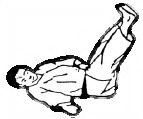
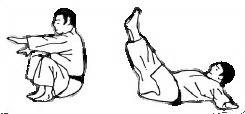

Techniques
For information, in this document all techniques are described to the right. This means all techniques are to be done on the opponents right side. Any attack by the opponent will be right sided. For left techniques, transpose left for right and vice versa.
Breakfalls (Ukemi)
Front crush
Standing with legs spread, turn feet outwards.
Lean low and slide forward on forearms into prone position. Head turned to the side on landing, hands turned slightly in to protect face.
Forearms and feet only on floor.
Rear Roll
From standing, place left knee on floor slightly behind original position, lower leg placed immediately behind body so that centre of calf is in line with right heel. Sit down in a curled position. Chin tucked in. Breakfall acceptable if done.
Side Breakfalls
From standing, slide right foot forward and sit onto right heel, keep in curled position and roll back onto right
shoulder. When shoulder
touches,
strike
floor with full length of arm,
palm downward,
with vigour. Chin kept
tucked in.
4
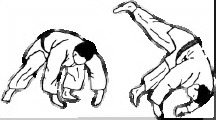

Rolling Breakfall
From standing step forward with right foot, reach forward with right hand, turn arm so that elbow is up, lean down and place palm as far back to rear foot as possible, Pushing with right foot, roll over right shoulder, as left side touches, strike floor with full
length of left arm, continue roll
onto small of back. Keeping
left leg tucked under right,
continue
roll
so
that
momentum forces body into
standing position. Keep
chin tucked in.
Ground defence
Lie on your back then turn onto your left side to face your opponent, raise your arms into a basic Crosssblock to protect your face. Bring the left knee toward your stomach and use the shin of 5
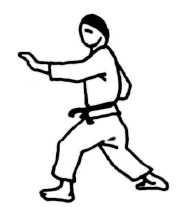
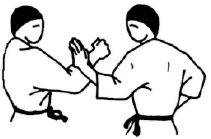
Posture
The most important item that you will ever learn in any Martial art is that of Posture, without it the majority of the techniques learned will be ineffectual.
To attain a good defensive posture - Stand with feet in line and slightly apart, now raise your arms above your head as though holding a sword, left hand in front of right. Keep your shoulders square to the front and bring the arms down to about chest height, still keeping the left in front of the right. Take an extended step back with the right foot but still facing the front, you will find that the right hand is moved back slightly but the left stays where it was.
Avoid & Deflect
The most important move in Taiho Jutsu. If you don’t avoid the attack how can you even attempt a technique?
Facing your opponent who is moving forward in a striking movement, either punching or kicking.
Move the left foot two inches to the left, then move the right foot three feet to the left, your body should be no more than 45° off the centre.
At the same time complete a little clockwise circle with the left hand to protect the face. If possible allow the left hand to rest on the opponents right forearm just above the wrist, making sure that the fingers and thumb are in a cupped position. Maintain the same posture, the punch or kick should pass you by. On no circumstance take hold of the forearm in a tight natural grip, or punch the arm away. If you are not there, neither attacks can harm you. Do not lean forward to deflect the punch, if a kick, treat it as a punch.
These two techniques are the most important that you will ever learn. The movement to 45° is to applied rigorously. There should be no exception.
6
Posture
Examiners notes
The student is given the following information regarding these two techniques so that understanding of Taiho can commence.
To attain the correct posture. Raise your hands above your head as though you have a sword gripped by the halt. Step back with the right foot as far as feels comfortable. Bring the hands downward in a striking movement to the centre of the chest. Open the palms and move the left hand forward and the right hand closer to the chest.
The examiner will be looking for relaxed hands, the back foot at a slight angle off centre, and the front leg from shin to knee to be perpendicular, shoulders upright. There must be no lean forward or back.
Avoid & Deflect.
Student / Examiner notes
Failure to understand this movement will restrict the student from advancement throughout his/her career.
To understand the reason and










